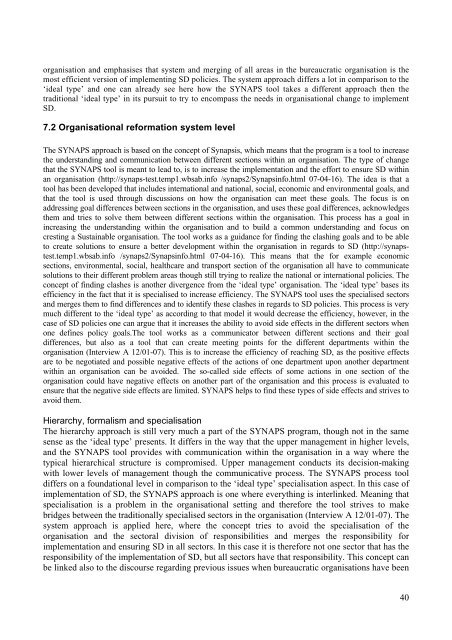From 'grey to green'- investigating the capabilities of the ... - lumes
From 'grey to green'- investigating the capabilities of the ... - lumes
From 'grey to green'- investigating the capabilities of the ... - lumes
You also want an ePaper? Increase the reach of your titles
YUMPU automatically turns print PDFs into web optimized ePapers that Google loves.
organisation and emphasises that system and merging <strong>of</strong> all areas in <strong>the</strong> bureaucratic organisation is <strong>the</strong>most efficient version <strong>of</strong> implementing SD policies. The system approach differs a lot in comparison <strong>to</strong> <strong>the</strong>‘ideal type’ and one can already see here how <strong>the</strong> SYNAPS <strong>to</strong>ol takes a different approach <strong>the</strong>n <strong>the</strong>traditional ‘ideal type’ in its pursuit <strong>to</strong> try <strong>to</strong> encompass <strong>the</strong> needs in organisational change <strong>to</strong> implementSD.7.2 Organisational reformation system levelThe SYNAPS approach is based on <strong>the</strong> concept <strong>of</strong> Synapsis, which means that <strong>the</strong> program is a <strong>to</strong>ol <strong>to</strong> increase<strong>the</strong> understanding and communication between different sections within an organisation. The type <strong>of</strong> changethat <strong>the</strong> SYNAPS <strong>to</strong>ol is meant <strong>to</strong> lead <strong>to</strong>, is <strong>to</strong> increase <strong>the</strong> implementation and <strong>the</strong> effort <strong>to</strong> ensure SD withinan organisation (http://synaps-test.temp1.wbsab.info /synaps2/Synapsinfo.html 07-04-16). The idea is that a<strong>to</strong>ol has been developed that includes international and national, social, economic and environmental goals, andthat <strong>the</strong> <strong>to</strong>ol is used through discussions on how <strong>the</strong> organisation can meet <strong>the</strong>se goals. The focus is onaddressing goal differences between sections in <strong>the</strong> organisation, and uses <strong>the</strong>se goal differences, acknowledges<strong>the</strong>m and tries <strong>to</strong> solve <strong>the</strong>m between different sections within <strong>the</strong> organisation. This process has a goal inincreasing <strong>the</strong> understanding within <strong>the</strong> organisation and <strong>to</strong> build a common understanding and focus oncresting a Sustainable organisation. The <strong>to</strong>ol works as a guidance for finding <strong>the</strong> clashing goals and <strong>to</strong> be able<strong>to</strong> create solutions <strong>to</strong> ensure a better development within <strong>the</strong> organisation in regards <strong>to</strong> SD (http://synapstest.temp1.wbsab.info/synaps2/Synapsinfo.html 07-04-16). This means that <strong>the</strong> for example economicsections, environmental, social, healthcare and transport section <strong>of</strong> <strong>the</strong> organisation all have <strong>to</strong> communicatesolutions <strong>to</strong> <strong>the</strong>ir different problem areas though still trying <strong>to</strong> realize <strong>the</strong> national or international policies. Theconcept <strong>of</strong> finding clashes is ano<strong>the</strong>r divergence from <strong>the</strong> ‘ideal type’ organisation. The ‘ideal type’ bases itsefficiency in <strong>the</strong> fact that it is specialised <strong>to</strong> increase efficiency. The SYNAPS <strong>to</strong>ol uses <strong>the</strong> specialised sec<strong>to</strong>rsand merges <strong>the</strong>m <strong>to</strong> find differences and <strong>to</strong> identify <strong>the</strong>se clashes in regards <strong>to</strong> SD policies. This process is verymuch different <strong>to</strong> <strong>the</strong> ‘ideal type’ as according <strong>to</strong> that model it would decrease <strong>the</strong> efficiency, however, in <strong>the</strong>case <strong>of</strong> SD policies one can argue that it increases <strong>the</strong> ability <strong>to</strong> avoid side effects in <strong>the</strong> different sec<strong>to</strong>rs whenone defines policy goals.The <strong>to</strong>ol works as a communica<strong>to</strong>r between different sections and <strong>the</strong>ir goaldifferences, but also as a <strong>to</strong>ol that can create meeting points for <strong>the</strong> different departments within <strong>the</strong>organisation (Interview A 12/01-07). This is <strong>to</strong> increase <strong>the</strong> efficiency <strong>of</strong> reaching SD, as <strong>the</strong> positive effectsare <strong>to</strong> be negotiated and possible negative effects <strong>of</strong> <strong>the</strong> actions <strong>of</strong> one department upon ano<strong>the</strong>r departmentwithin an organisation can be avoided. The so-called side effects <strong>of</strong> some actions in one section <strong>of</strong> <strong>the</strong>organisation could have negative effects on ano<strong>the</strong>r part <strong>of</strong> <strong>the</strong> organisation and this process is evaluated <strong>to</strong>ensure that <strong>the</strong> negative side effects are limited. SYNAPS helps <strong>to</strong> find <strong>the</strong>se types <strong>of</strong> side effects and strives <strong>to</strong>avoid <strong>the</strong>m.Hierarchy, formalism and specialisationThe hierarchy approach is still very much a part <strong>of</strong> <strong>the</strong> SYNAPS program, though not in <strong>the</strong> samesense as <strong>the</strong> ‘ideal type’ presents. It differs in <strong>the</strong> way that <strong>the</strong> upper management in higher levels,and <strong>the</strong> SYNAPS <strong>to</strong>ol provides with communication within <strong>the</strong> organisation in a way where <strong>the</strong>typical hierarchical structure is compromised. Upper management conducts its decision-makingwith lower levels <strong>of</strong> management though <strong>the</strong> communicative process. The SYNAPS process <strong>to</strong>oldiffers on a foundational level in comparison <strong>to</strong> <strong>the</strong> ‘ideal type’ specialisation aspect. In this case <strong>of</strong>implementation <strong>of</strong> SD, <strong>the</strong> SYNAPS approach is one where everything is interlinked. Meaning thatspecialisation is a problem in <strong>the</strong> organisational setting and <strong>the</strong>refore <strong>the</strong> <strong>to</strong>ol strives <strong>to</strong> makebridges between <strong>the</strong> traditionally specialised sec<strong>to</strong>rs in <strong>the</strong> organisation (Interview A 12/01-07). Thesystem approach is applied here, where <strong>the</strong> concept tries <strong>to</strong> avoid <strong>the</strong> specialisation <strong>of</strong> <strong>the</strong>organisation and <strong>the</strong> sec<strong>to</strong>ral division <strong>of</strong> responsibilities and merges <strong>the</strong> responsibility forimplementation and ensuring SD in all sec<strong>to</strong>rs. In this case it is <strong>the</strong>refore not one sec<strong>to</strong>r that has <strong>the</strong>responsibility <strong>of</strong> <strong>the</strong> implementation <strong>of</strong> SD, but all sec<strong>to</strong>rs have that responsibility. This concept canbe linked also <strong>to</strong> <strong>the</strong> discourse regarding previous issues when bureaucratic organisations have been40
















